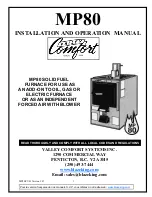
Page 17
Figure 10
A54
A15
Heat Pump Applications
Clip red jumper from R to O
close to R terminal.
Make pigtail
connection and run wire from
terminal O to O terminal on
thermostat.
To blower
motor
ADJUST
The
ADJUST
pins affect blower motor speed during cool-
ing operation only. The ADJUST feature allows the motor
to run at normal speed, approximately 15% higher than
normal speed, or 15% lower than normal speed during the
cooling mode. Table 7 gives three rowsNORM, (+), and
(–) with their respective CFM volumes. Notice that the nor-
mal NORM" adjustment setting for cool speed position C
in table 7 is 800 CFM. The (+)" adjustment setting for that
position is 920 CFM (115% of 800 CFM) and the (–)" ad-
justment setting is 680 CFM (85% of 800 CFM). After the
adjustment setting has been determined, choose the re-
maining speed settings from those offered in the table in
that row.
HEAT
The unit is factory−set to run at the middle of heating rise
range as shown on the unit rating plate. The jumper on the
tap marked
HEAT
must remain in the position given in table
7.
The
HEAT
jumper is used to determine CFM during heat-
ing operation only. These jumper selections are activated
only when W1 is energized.
During the heat ON delay, the blower runs at 13% CFM for
the first minute, 50% CFM for the second minute, and full
CFM after two minutes.
OFF
CALL
100%
82%
50%
13%
W
60
sec
60
sec
210 seconds
w
W − Heat Demand Present
w − Heat Demand Satisfied
When the demand for heat is met, the blower ramps down
to 82% CFM for 3−1/2 minutes, then turns off.
TEST
The TEST pin is available to bypass the blower control and
run the motor at approximately 70% to make sure that the
motor is operational. This is used mainly in troubleshoot-
ing. The G terminal must be energized for the motor to run.
CFM LED
The
CFM
LED located on the blower control flashes one
time per 100 cfm to indicate selected blower speed. For
example, if the unit is operating at 1000 CFM, the
CFM
LED will flash 10 times.
At times, the light may appear to flicker or glow. This takes
place when the control is communicating with the motor
between cycles. This is normal operation.
After the CFM for each application has been determined,
the jumper settings must be adjusted to reflect those given
in table 7. From the table, determine which row most close-
ly matches the desired CFM. Once a specific row has been
chosen (+, NORMal, or −), CFM volumes from other rows
cannot be used. Below are descriptions of the jumper
selections.
The variable speed motor slowly ramps up to and down
from the selected air flow during both cooling and heating
demand. This minimizes noise and eliminates the initial
blast of air when the blower is initially energized.
Continuous Fan
When the thermostat is set for Continuous Fan" operation
and there is no demand for heating or cooling, the blower
control will provide 50% of the
COOL
CFM selected.
OFF
CALL
50%
G
g
G − Fan switch ON
g − Fan switch OFF
NOTE − With the proper thermostat and subbase, continu-
ous blower operation is possible by closing the R to G cir-
cuit.
Dehumidification
The A54 blower control (see figure 11) includes a HUM ter-
minal which provides for connection of a humidistat. The
JW1 jumper on the blower control must be cut to activate
the HUM terminal. The humidistat must be wired to open
on humidity rise. When the dehumidification circuit is used,
the variable speed motor will reduce the selected air flow
rate by 18% when humidity levels are high. An LED (D1)
lights when the blower is operating in the dehumidification
mode.
Humidification
Terminals are provided on the A15 control for 120 volt out-
put to operate a humidifier. The HUM" terminal is ener-
gized when there is a call for heat. See figure 13.
Indoor Air Quality (IAQ) Accessory
An EAC terminal is provided on the A15 control for 120 volt
output to an indoor air quality accessory. The EAC terminal
is energized when there is a call for heat, cool, or continu-
ous blower. See figure 13.












































